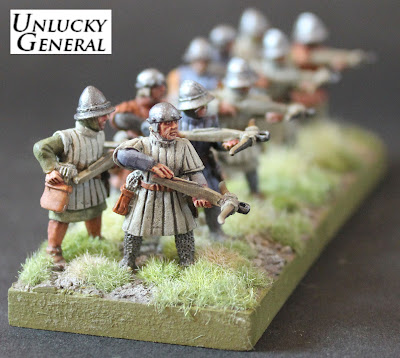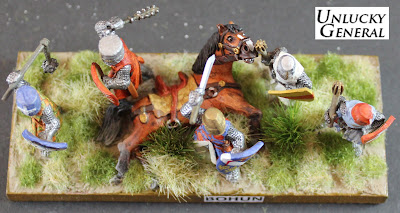Sharing an Idea: Fall of the Foot
Admittedly, I'm not doing a lot on this project for the time being having been posted to Tonga. I am painting and building but not anything toward this project for the present. Nevertheless, it forever returns to mind.
I have been listening to Dan Carlin's Hardcore History and in particular his discussions concerning armies across the ages and their respective styles of warfare. If you aren't familiar with Mr Carlin's broadcasts or other works, he is no academic as such but a public broadcaster. A Bachelor graduate in history much like myself, he has a lifelong interest and studies human history including warfare, politics and religion. I have only just discovered his podcasts which I find to be entertaining and thought provoking. He is quite clearly a thinker.
Mr Carlin was specifically discussing the failure of Eastern armies over the past three hundred or so years and conversely, the general comparative failure of western armies prior to this. It is a general, multi-millennial assessment taking note of considerable divergent periods but looks toward those tidal marks where West meets East.
What has this got to do with Lewes? Well, he speaks about the psychological and cultural resistance to change and other motivations preventing what we might otherwise assume to be logical military developments. A brief side reference he made, but of critical interest to me was the disinterest of ruling elites in developing the military capacity of their subjects. In fact, it goes further than that and prompts an analysis of an elite's vested interests in preventing the development of their subjects military capability.
I have for some time struggled in coming to terms with the erosion of medieval infantry and their ability to deal with mounted opponents. I keep going back to the failure of de Montfort's London militia to hold their ground against Prince Edward's admittedly massive cavalry assault. I have asked myself how was it that the Saxon shield wall on Senlac Hill sustained repeated Normal cavalry assaults but thousands of formed spearmen atop Lewes Downs failed to hold the higher ground? Less than 100 years later their descendants were fouling the ground and preparing improvised field defences against even heavier and presumably superior French cavalry during the Hundred Years War. On the surface, I feel I am presented with a sandwiched period where the supremacy of the knight is well recognised but little assessment of what happened to the foot is entered into.
Several factors come into play it seems. There had been no major battle on open ground in England since Hastings. That's a broad statement I realise. The subsequent generations who endured the civil wars of Geoffrey and Maud in the twelfth century and the First Baron's War of the early thirteenth fought battles in largely urban environments and revolved around sieges. The London militia by the mid-thirteenth century had never experienced battle requiring co-ordinated formations against enemy cavalry. They would not have been organizationally or particularly psychologically experienced. In fact, they would never have co-operated in the field against any large formed bodies of enemy soldiers of any type. Captains would have had little experience either - being drawn on the basis of social status rather than real battle experience - genuine veterans being hard to come by.
Back to Carlin's comments, it would not have been in the ruling elites interest to teach the common Englishmen how to resist a mounted knight. Post Hastings, warfare within the British Isles was radically altered with the appearance and immediate dominance of the mounted knight. Once Saxon society was dismantled there was no one left to organise the Fyrd. A levy of troops was a rare thing and the new masters of England preferred mercenaries and castles from which their unstoppable mounted forces would sally forth to settle whatever needed settling.
In open battle, the foot supported the mounted knights, squires and sergeants who were the shock troops and battle-winning arm of armies. This was how the ruling classes liked it.
The Saxon, north european culture which fueled warfare on foot and put spine in the shield wall was long gone. Norman England had no need for a shield wall and less desire for one. The domination of high status mounted warriors became the introduced reality reinforced by an unidentified but effective military doctrine which supported the imposed social structure.
If I look at what changed in the English military tradition by the time of the Hundred Years War, it was that warfare was something which came to be fought externally. Over such a long period of time, the development and refinement of the infantry into a professional body of mobile yeoman longbow men may have only been socially possible because they were fighting abroad. Even for that generation which followed the Second Barons' War, military effort was directed outwards in the expansionist wars of Edward I against the Welsh and the Scots.
Of course, society had also changed and the ruing elites had long since ceased to become foreign in the same sense as their eleventh century forebears. By the time of Crecy, the common man who made up the foot soldiery must have seemed more 'us' than 'them' in the minds of their masters.
So, looking back to the day at Lewes, de Montfort had spread his cavalry more or less evenly amongst this four wards. Whilst taking the high ground determining the time and place of battle, he cannot have predicted that the Royal army would have massed so much of it's cavalry arm on one wing. As thousands of horsemen charged up the slope toward his left wing it must have seemed that the rebels were doomed - even with defence in depth and on higher ground.
It's one of those 'what-if's' of history for me. At least now feel I better understand the reasons behind the abilities or otherwise of the foot and London militia in particular.
For those of you who already appreciated this ... I apologise for being so dim and taking so long to catch up.
I have been listening to Dan Carlin's Hardcore History and in particular his discussions concerning armies across the ages and their respective styles of warfare. If you aren't familiar with Mr Carlin's broadcasts or other works, he is no academic as such but a public broadcaster. A Bachelor graduate in history much like myself, he has a lifelong interest and studies human history including warfare, politics and religion. I have only just discovered his podcasts which I find to be entertaining and thought provoking. He is quite clearly a thinker.
Mr Carlin was specifically discussing the failure of Eastern armies over the past three hundred or so years and conversely, the general comparative failure of western armies prior to this. It is a general, multi-millennial assessment taking note of considerable divergent periods but looks toward those tidal marks where West meets East.
What has this got to do with Lewes? Well, he speaks about the psychological and cultural resistance to change and other motivations preventing what we might otherwise assume to be logical military developments. A brief side reference he made, but of critical interest to me was the disinterest of ruling elites in developing the military capacity of their subjects. In fact, it goes further than that and prompts an analysis of an elite's vested interests in preventing the development of their subjects military capability.
I have for some time struggled in coming to terms with the erosion of medieval infantry and their ability to deal with mounted opponents. I keep going back to the failure of de Montfort's London militia to hold their ground against Prince Edward's admittedly massive cavalry assault. I have asked myself how was it that the Saxon shield wall on Senlac Hill sustained repeated Normal cavalry assaults but thousands of formed spearmen atop Lewes Downs failed to hold the higher ground? Less than 100 years later their descendants were fouling the ground and preparing improvised field defences against even heavier and presumably superior French cavalry during the Hundred Years War. On the surface, I feel I am presented with a sandwiched period where the supremacy of the knight is well recognised but little assessment of what happened to the foot is entered into.
Several factors come into play it seems. There had been no major battle on open ground in England since Hastings. That's a broad statement I realise. The subsequent generations who endured the civil wars of Geoffrey and Maud in the twelfth century and the First Baron's War of the early thirteenth fought battles in largely urban environments and revolved around sieges. The London militia by the mid-thirteenth century had never experienced battle requiring co-ordinated formations against enemy cavalry. They would not have been organizationally or particularly psychologically experienced. In fact, they would never have co-operated in the field against any large formed bodies of enemy soldiers of any type. Captains would have had little experience either - being drawn on the basis of social status rather than real battle experience - genuine veterans being hard to come by.
Back to Carlin's comments, it would not have been in the ruling elites interest to teach the common Englishmen how to resist a mounted knight. Post Hastings, warfare within the British Isles was radically altered with the appearance and immediate dominance of the mounted knight. Once Saxon society was dismantled there was no one left to organise the Fyrd. A levy of troops was a rare thing and the new masters of England preferred mercenaries and castles from which their unstoppable mounted forces would sally forth to settle whatever needed settling.
In open battle, the foot supported the mounted knights, squires and sergeants who were the shock troops and battle-winning arm of armies. This was how the ruling classes liked it.
The Saxon, north european culture which fueled warfare on foot and put spine in the shield wall was long gone. Norman England had no need for a shield wall and less desire for one. The domination of high status mounted warriors became the introduced reality reinforced by an unidentified but effective military doctrine which supported the imposed social structure.
If I look at what changed in the English military tradition by the time of the Hundred Years War, it was that warfare was something which came to be fought externally. Over such a long period of time, the development and refinement of the infantry into a professional body of mobile yeoman longbow men may have only been socially possible because they were fighting abroad. Even for that generation which followed the Second Barons' War, military effort was directed outwards in the expansionist wars of Edward I against the Welsh and the Scots.
Of course, society had also changed and the ruing elites had long since ceased to become foreign in the same sense as their eleventh century forebears. By the time of Crecy, the common man who made up the foot soldiery must have seemed more 'us' than 'them' in the minds of their masters.
So, looking back to the day at Lewes, de Montfort had spread his cavalry more or less evenly amongst this four wards. Whilst taking the high ground determining the time and place of battle, he cannot have predicted that the Royal army would have massed so much of it's cavalry arm on one wing. As thousands of horsemen charged up the slope toward his left wing it must have seemed that the rebels were doomed - even with defence in depth and on higher ground.
It's one of those 'what-if's' of history for me. At least now feel I better understand the reasons behind the abilities or otherwise of the foot and London militia in particular.
For those of you who already appreciated this ... I apologise for being so dim and taking so long to catch up.



Comments